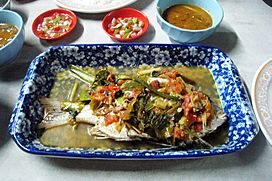Woku facts for kids

Red Snapper Woku
|
|
| Course | Main course |
|---|---|
| Place of origin | Indonesia |
| Region or state | North Sulawesi |
| Serving temperature | Hot |
| Main ingredients | Chicken or seafood in hot and spicy spice mixture |
Woku is a special kind of spice mixture from Indonesia. It comes from the Manado area in North Sulawesi. Woku is known for its amazing smell and spicy kick!
This tasty spice mix is made from many different ingredients. It includes ground spices like red ginger, turmeric, and candlenut. It also has fresh ingredients like red chili pepper, chopped shallots, scallions, and tomatoes. Plus, you'll find lemon or citrus leaves, turmeric leaves, lemon basil leaves, and lemongrass.
To make a woku dish, main ingredients like chicken or fish are first rubbed with salt and lime juice. They sit for about 30 minutes to soak up the flavors. Then, all the spices are cooked in coconut oil until they smell wonderful. Finally, the main ingredients, water, and a little salt are added. Everything cooks together until it's perfectly done and delicious!
What's in a Name?
The name "Woku" comes from something called daun woka. Daun woka is a type of young coconut leaf. These leaves were traditionally used to wrap rice, like a natural package.
Originally, woku dishes were wrapped in these young coconut leaves or banana leaves before cooking. This is similar to how other Indonesian dishes like pepes or ketupat are prepared. So, the dish got its name from the special leaves used to cook it!
Different Kinds of Woku
You can make almost any kind of meat, chicken, or seafood into a woku dish. It's a very flexible spice mixture!
The most common and popular woku dishes are:
- Ayam woku: This is woku made with chicken.
- Kakap woku: This dish uses red snapper fish.
There are also different ways to cook woku:
- Woku belanga: This type of woku is cooked in a belanga. A belanga is a traditional clay pot or any kind of saucepan.
- Woku daun: This is a woku dish that is cooked while wrapped in banana leaves or woka (young coconut) leaves.

